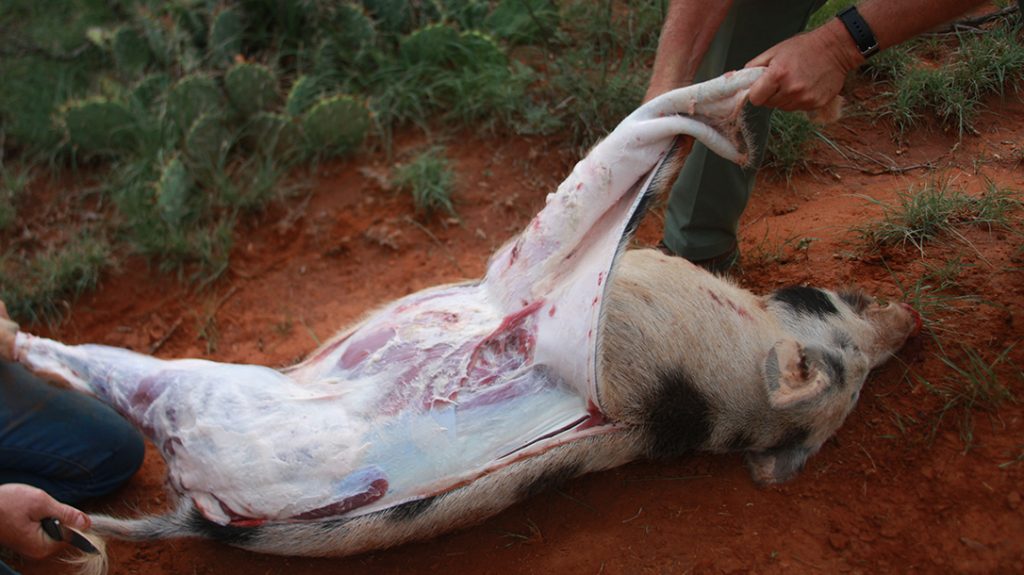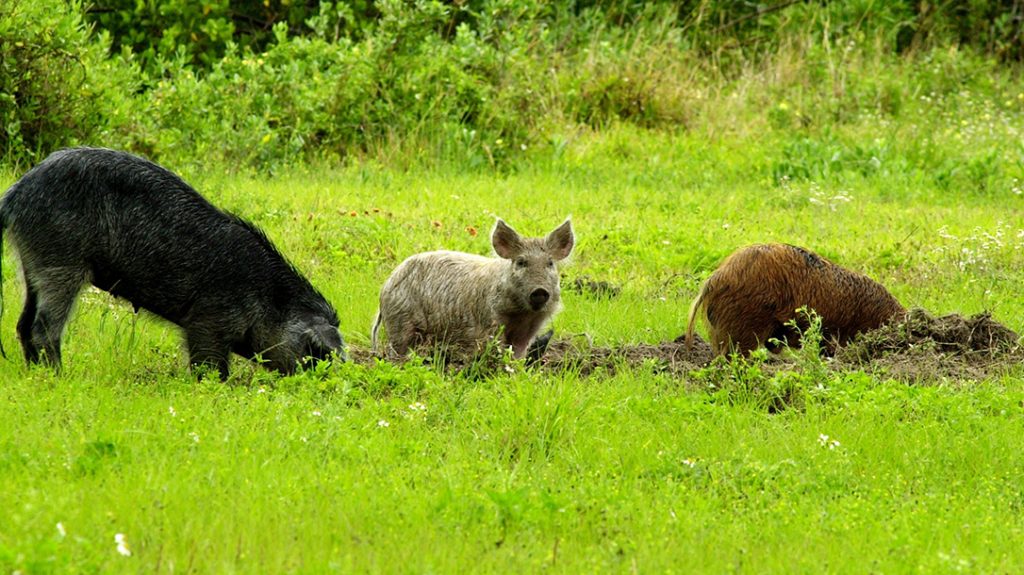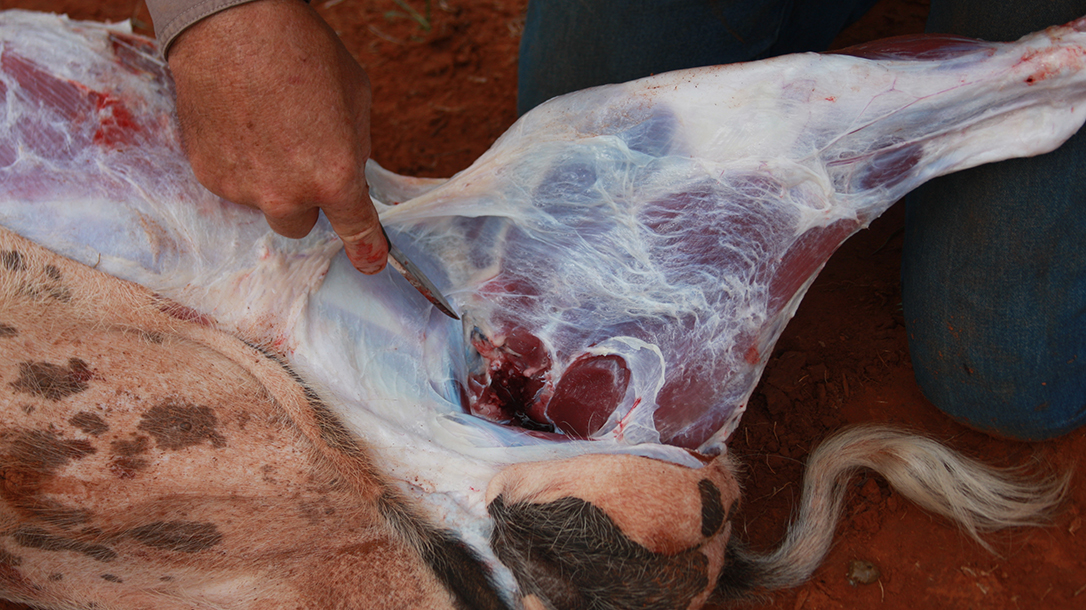Feral hogs, the wild-roaming offspring of domestic herds, are becoming an increasing problem throughout many southern states. Where agriculture is a livelihood, a wild hog is a potent threat. Hogs rooting the ground destroy crops. For this reason and others states like Texas consider feral hogs to be varmints, allowing them to be hunted without limit with only a basic hunting license. If eradication is your goal, you can skip this, but as a sportsman, read on. What do you do with the hog after you have harvested it? The sportsman’s answer is to butcher and eat it.
If you can haul your hog to camp or have a block and tackle and a strong tree, then the traditional gut-and-skin method will work. But in many parts of the country, like large tracts of Texas, suitable trees may not be available. Therefore, here we will cover the “no gut” field butchering method.
How to Field Butcher a Wild Hog
The most important tool you need is a very sharp drop-point knife. The flat spine of the drop point rides along on the bone while the sharp edge cuts the hide from the inside out. Cutting from the inside out reduces the amount of hair that will get on your meat.
Advertisement — Continue Reading Below
Field butchering can be tough on a knife. Hogs love to roll in the mud and their skin and hair are covered with sand and dirt. You’ll help keep your blade sharp by cutting from the inside out, but it is also wise to have a sharpening stick handy.
We start with the wild hog on the ground. Work one entire side and then turn it over to repeat the process. We cut open the back from where the tail meets to the base of the skull. Cut along the back of the hind leg until it meets the first cut along the back. Cut around the leg and then up the front of the leg. Continue this cut along the tip of the ribs and then down the back of the front leg.

Advertisement — Continue Reading Below
Circle cut around the front leg, ending around the jowl. The back cut and the belly cut should not meet. After these cuts, grasp the skin at the rear and pull forward. The skin can be cut free as you go, or if two hunters are available, one holds the hind quarter and the other hunter pulls the skin. By yourself? Tie the hind quarter to something stout and pull the hide yourself. With the skin pulled away, the hair is gone and the meat is exposed for cutting.
Wild Hog Hindquarters
Except for some unlucky shooting, the hindquarters should be undamaged, and that is the next step. Grasp the foot and lift the leg up and over the back. The point here is to put tension on all the muscles. Use your knife to cut any muscle that appears to have tension. All this cutting is done inwards, towards the joint of the leg and the hip. Continue to apply more tension as you proceed. You can stick the hoof behind your knee and squeeze it to create a third hand if it makes the tension and cutting easier to do.
There is no need to saw or hack at the joint, just keep cutting across the face of the joint, and when it is free of the muscle, the joint rolls open. Continue cutting around the front of the leg towards the open joint. Very soon the whole leg comes off. To separate the hoof from the knee, hold the hoof and turn the whole leg over to stretch the knee. Look for the knee sinew, which is the long white surface about 6 inches long.
Advertisement — Continue Reading Below
From the end of the sinew nearest your hand go up about one-third the overall length. This should be the back of the joint. Cut across the sinew and the knee joint will open and the hoof will come off. I do this step over a heavy plastic bag to catch the leg as it drops free. I also keep a heavy-duty canvas tote bag handy that conveniently carries the plastic bag full of meat.
Shoulder Cuts
Lift the leg up and towards the head of the wild hog. Cut inwards towards the shoulder blade. Cut under the shoulder blade; lift and separate at any muscle showing tension. There is no joint and the shoulder will come loose when all of the connecting tissue is cut. Disjoint the hoof in the same manner as you did on the hindquarter.
Next is the loin, not to be confused with the tenderloin. Many hunters will call this the back strap, a generic reference. The loin lies along both sides of the backbone. You can start at the front or back depending on whether you are right- or left-handed. Move around the hog and work on the side and direction that is most convenient for you. At your preferred end, find where the loin meets the top of the backbone. Use the tip of the knife to cut along this junction. The bone curves down and out to the ribs. Continue to work along and down until the loin is free of the backbone. Somewhere about the top of the shoulder you run out of loin, so take what you want. Cut across the loin to free it completely and put it in your plastic bag.
Advertisement — Continue Reading Below
Racking Up Ribs
The ribs are frequently left behind because traditional methods require gutting the wild hog in order to saw the ribs off the backbone. But the field method again shines here. The answer is pruning shears. The shears should be able to cut a 1- to 2-inch branch. If you have the hand strength, smaller hand snippers may work for you. If not, pruning shears with long handles will easily do the job.

Slip the lower jaw of the cutter under the ribs and start cutting until they are loose. Continue until one end of the ribs is cut loose. Lift the cut end of the ribs and cut off the underside. It takes a little cutting to free the ribs of the connecting tissue. At the tail end of the ribs are the short ribs and underneath them the tenderloin. While cutting out the ribs, take care not to cut into the intestines. It’s not difficult to avoid this, but a warning goes a long way in not making a mess of things.
Advertisement — Continue Reading Below
Wild Hog Butchering Tools
Pruning shears are not a common hunting camp tool, but a hatchet is. And the hatchet can also be used to remove the ribs. Like your knife, your hatchet should be very sharp. To swing the hatchet and avoid cutting into the intestines, it is well to use two hands and a very short stoke. Kneel facing the hog’s back. The short chop swing is only about 3 to 4 inches. Cut through only the end of a single rib at a time.
The swing is parallel to and along the backbone. If you use two hands, you can chop accurately and limit the possibility of striking off your hand or knee with the very sharp axe. The axe is efficient but also requires a greater amount of skill. I prefer using pruning shears. At this point you take one of the hog’s legs, still attached on the other side, and roll the critter over. Now start the process over on the other side.
Hunter’s Harvest
Unlike a meat packer’s butchering technique, this field method does leave quite a bit of meat on the ground. However, it is not an unreasonable amount. What is taken is prime and what is left can be almost be regarded as recycling. The internals have limited appeal; the shoulders are frequently damaged by a well-placed shot and the head, even in the best of situations, requires special handling. This method harvests the hindquarters (ham), loin (back strap), long and short ribs, tenderloins and front quarters (picnic and shoulder). That’s not a bad haul straight out of the field. If this field butchering method is done correctly, it reduces the hair on the meat and nothing that is left on the ground goes to waste. There are plenty of other animals that will happily feed on the carcass. The only thing left is packaging or cooking.
Advertisement — Continue Reading Below
With only a general hunting license, year-round season, no bag limits, meat is plentiful where feral hogs are around. Our thanks to Garrett Cartridges of Texas (garrettcartridges.com) for the use of its Texas hunting lease in harvesting the wild hog presented here.
Feral Pig Meat Safety
Hunting wild boar can be one of the most fast-paced pursuits around. But, don’t get too caught up in the chase to neglect taking care of yourself, and your hunting dogs, if you use them. Wild boar meat can be infected with a number of diseases, with pseudorabies and brucellosis being the most common. The former can be spread through raw meat consumption and saliva. It is thus often transmitted to hunting dogs since they are most susceptible to bites. Pseudorabies is not fatal to humans, but it is always fatal to dogs. Intense itching is the telltale sign. Brucellosis can also be transmitted through raw meat consumption and affects humans, too. Some symptoms include miscarriages in all animals who carry the disease.
To prevent the spread of illness, plan ahead, and be diligent about hygiene during and after a hunt. Wear long pants, sleeves, gloves and eye protection when handling live hogs or raw meat. Always wash your hands thoroughly and disinfect all surfaces used to butcher meat. Be sure to cook pork to an internal temperature of 160 degrees F. and chill or freeze all uncooked pork right away.
Advertisement — Continue Reading Below
To keep your dogs safe, remove them from the pigs as soon as possible, making it a priority to disinfect their mouths and any wounds right away. Never feed them raw pork, and keep them up to date on veterinary testing.
With a little precaution, you can have your pig and eat it, too.
Wild Boar Pork Chops Recipe
The trick to cooking the lean meat of wild boar is to go low and slow. Overcooking is something to be particularly avoided as the meat can easily become tough. Aim for getting the meat to 160 degrees F. for safety, but be sure not to go much further than that. This recipe for chops from askthemeatman.com lets the meat’s flavor shine through, but also offers a robust sauce to help keep the meat moist.
Advertisement — Continue Reading Below
Ingredients:
- 2 wild boar chops
- 2 tablespoons oil
- 4 tablespoons flour
- Salt and pepper to taste
- 1 tablespoon mustard
- A bottle of your favorite beer
- 1 teaspoon chopped garlic
- Cup beef broth
Directions:
Preheat oven to 300 degrees F. Dredge the chops in flour, salt, and pepper mixture. Heat oil and add meat. Cook until lightly browned. Remove chops, drain grease, but save brown bits in the pan. Add the beer, mustard, garlic, and broth. Simmer for 15 minutes. Return chops to the pan (or to a pan that is oven safe), cover, and bake for 45 minutes.
This article is from a previous issue of The New Pioneer Magazine. Grab your copy at OutdoorGroupStore.com.






















